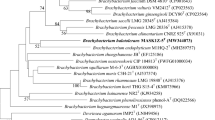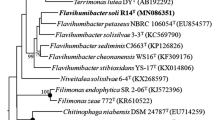Abstract
Two Gram-stain-positive, oxidase-negative, catalase-positive, and coccus-shaped bacterial strains, designated CBA3104T and CBA3105T, were isolated from kimchi. Strain CBA3104T and CBA3105T grew at 10–35°C (optimum, 25°C and 30°C, respectively), at pH 6.0–8.5 (optimum, pH 6.5), and in the presence of 0–15% (w/v) NaCl (optimum, 5%). A phylogenetic analysis based on 16S rRNA gene sequences revealed that strain CBA3104T formed a distinct phylogenetic lineage within the genus Brachybacterium whereas strain CBA3105T was closely positioned with Brachybacterium halotolerans MASK1Z-5T. The 16S rRNA gene sequence similarity between strains CBA3104T and CBA3105T was 99.9%, but ANI and dDDH values between strains CBA3104T and CBA3105T were 93.61% and 51.5%, respectively. Strain CBA3104T showed lower ANI and dDDH values than species delineation against three closely related strains and type species of the genus Brachybacterium, however, strain CBA3105T showed 96.63% ANI value and 69.6% dDDH value with Brachybacterium halotolerans MASK1Z-5T. Among biochemical analysis results, strain CBA3104T could uniquely utilize bromo-succinic acid whereas only strain CBA3105T was positive for alkaline phosphatase and α-fucosidase among two novel strains, closely related strains, and type species of the genus Brachybacterium. Compared with strain CBA3105T and Brachybacterium halotolerans JCM 34339T, strain CBA3105T was differentially positive for acid production of d-arabinose, d-adonitol, and potassium 5-ketogluconate and enzyme activity of β-glucuronidase. Both strains contained menaquinone-7 as the dominant quinone. The cell-wall peptidoglycan of two novel strains contained meso-diaminopimelic acid. The major fatty acids of strains CBA3104T and CBA3105T were anteiso-C15:0, anteiso-C17:0, and iso-C16:0. The major polar lipids of both strains were phosphatidylglycerol and diphosphatidylglycerol. Strain CBA3104T possessed a uniquely higher abundance of tRNA (97 tRNAs) than four Brachybacterium strains used for comparative taxonomic analysis (54–62 tRNAs). Both the CBA3104T and CBA3105T strain harbored various oxidoreductase, transferase, hydrolase, and lyase as strain-specific functional genes compared to closely related strains and Brachybacterium type species. The results of biochemical/physiological, chemotaxonomic, and genomic analyses demonstrated that strains CBA3104T and CBA3105T represent a novel species of the genus Brachybacterium and a novel subspecies of B. halotolerans, respectively, for which the names Brachybacterium kimchii sp. nov. and B. halotolerans subsp. kimchii subsp. nov. are proposed. The type strains of the novel species and the novel subspecies are CBA3104T (= KCCM 43417T = JCM 34759T) and CBA3105T (= KCCM 43418T =JCM 34760T), respectively.
Similar content being viewed by others
References
Benson, H.J. 1994. Microbiological Applications: A Laboratory Manual in General Microbiology. 6th edn., Brown Publishers, London, United Kindom.
Cantalapiedra, C.P., Hernández-Plaza, A., Letunic, I., Bork, P., and Huerta-Cepas, J. 2021. eggNOG-mapper v2: Functional annotation, orthology assignments, and domain prediction at the metagenomic scale. Mol. Biol. Evol. 38, 5825–5829.
Chen, M.S., Li, F.N., Chen, X.H., Yan, X.R., and Tuo, L. 2021. Brachybacterium halotolerans sp. nov., a halotolerant, endophytic actinomycete isolated from branch of Bruguiera gymnoirhiza. Antonie van Leeuwenhoek 114, 875–884.
Clark, K., Karsch-Mizrachi, I., Lipman, D.J., Ostell, J., and Sayers, E.W. 2016. GenBank. Nucleic Acids Res. 44, D67–D72.
Collins, M.D., Brown, J., and Jones, D. 1988. Brachybacterium faecium gen. nov., sp. nov., a coryneform bacterium from poultry deep litter. Int. J. Syst. Evol. Microbiol. 38, 45–48.
Felsenstein, J. 1981. Evolutionary trees from gene frequencies and quantitative characters: finding maximum likelihood estimates. Evolution 35, 1229–1242.
Fitch, W.M. 1971. Toward defining the course of evolution: minimum change for a specific tree topology. Syst. Zool. 20, 406–416.
Goris, J., Konstantinidis, K.T., Klappenbach, J.A., Coenye, T., Vandamme, P., and Tiedje, J.M. 2007. DNA-DNA hybridization values and their relationship to whole-genome sequence similarities. Int. J. Syst. Evol. Microbiol. 57, 81–91.
Groth, I., Schumann, P., Rajney, F.A., Martin, K., Schuetze, B., and Augsten, K. 1997. Bogoriella caseilytica gen. nov., sp. nov., a new alkaliphilic actinomycete from a soda lake in Africa. Int. J. Syst. Bacteriol. 47, 788–794.
Hiraishi, A., Ueda, Y., Ishihara, J., and Mori, T. 1996. Comparative lipoquinone analysis of influent sewage and activated sludge by high-performance liquid chromatography and photodiode array detection. J. Gen. Appl. Microbiol. 42, 457–469.
Kanehisa, M. and Goto, S. 2000. KEGG: Kyoto encyclopedia of genes and genomes. Nucleic Acids Res. 28, 27–30.
Kaur, G., Kumar, N., Mual, P., Kumar, A., Kumar, R.M., and Mayilraj, S. 2016. Brachybacterium aquaticum sp. nov., a novel actinobacterium isolated from seawater. Int. J. Syst. Evol. Microbiol. 66, 4705–4710.
Lee, I., Chalita, M., Ha, S.M., Na, S.I., Yoon, S.H., and Chun, J. 2017. ContEst16S: an algorithm that identifies contaminated prokaryotic genomes using 16S RNA gene sequences. Int. J. Syst. Evol. Microbiol. 67, 2053–2057.
Lee, I., Kim, Y.O., Park, S.C., and Chun, J. 2016. OrthoANI: an improved algorithm and software for calculating average nucleotide identity. Int. J. Syst. Evol. Microbiol. 66, 1100–1103.
Liu, Q.Q., Wang, Y., Li, J., Du, Z.J., and Chen, G.J. 2014a. Saccharicrinis carchari sp. nov., isolated from a shark, and emended descriptions of the genus Saccharicrinis and Saccharicrinis fermentans. Int. J. Syst. Evol. Microbiol. 64, 2204–2209.
Liu, Y., Xie, Q.Y., Shi, W., Li, L., An, J.Y., Zhao, Y.M., and Hong, K. 2014b. Brachybacterium huguangmaarense sp. nov., isolated from Lake sediment. Int. J. Syst. Evol. Microbiol. 64, 1673–1678.
Meier-Kolthoff, J.P., Auch, A.F., Klenk, H.P., and Göker, M. 2013. Genome sequence-based species delimitation with confidence intervals and improved distance functions. BMC Bioinformatics 14, 60.
Miller, L.T. 1982. Single derivatization method for routine analysis of bacterial whole-cell fatty acid methyl esters, including hydroxy acids. J. Clin. Microbiol. 16, 584–586.
Ming, H., Cheng, L., Yi, B., Xia, T., Niu, M., Zhao, Z., Liu, B., Nie, G., and Cui, C. 2021. Brachybacterium subflavum sp. nov., a novel actinobacterium isolated from the foregut of grass carp. Int. J. Syst. Evol. Microbiol. 71. doi: https://doi.org/10.1099/ijsem.0.004839.
Minnikin, D.E., O’donnell, A., Goodfellow, M., Alderson, G., Athalye, M., Schaal, A., and Parlett, J. 1984. An integrated procedure for the extraction of bacterial isoprenoid quinones and polar lipids. J. Microbiol. Methods 2, 233–241.
Page, A.J., Cummins, C.A., Hunt, M., Wong, V.K., Reuter, S., Holden, M.T.G., Fookes, M., Falush, D., Keane, J.A., and Parkhill, J. 2015. Roary: rapid large-scale prokaryote pan genome analysis. Bioinformatics 31, 3691–3693.
Park, S.K., Kim, M.S., Jung, M.J., Nam, Y.D., Park, E.J., Roh, S.W., and Bae, J.W. 2011. Brachybacterium squillarum sp. nov., isolated from salt-fermented seafood. Int. J. Syst. Evol. Microbiol. 61, 1118–1122.
Parker, C.T., Tindall, B.J., and Garrity, G.M. 2019. International Code of Nomenclature of Prokaryotes. Int. J. Syst. Evol. Microbiol. 69, S1–S111.
Parks, D.H., Imelfort, M., Skennerton, C.T., Hugenholtz, P., and Tyson, G.W. 2015. CheckM: assessing the quality of microbial genomes recovered from isolates, single cells, and metagenomes. Genome Res. 25, 1043–1055.
Rice, P., Longden, I., and Bleasby, A. 2000. EMBOSS: the European molecular biology open software suite. Trends Genet. 16, 276–277.
Saitou, N. and Nei, M. 1987. The neighbor-joining method: a new method for reconstructing phylogenetic trees. Mol. Biol. Evol. 4, 406–425.
Sasser, M. 1990. Identification of bacteria by gas chromatography of cellular fatty acids. MIDI Technical Note 101. MIDI Inc., Newark, Delaware, USA.
Schleifer, K.H. and Kandler, O. 1972. Peptidoglycan types of bacterial cell walls and their taxonomic implications. Bacteriol. Rev. 36, 407–477.
Schubert, K., Ludwig, W., Springer, N., Kroppenstedt, R.M., Accolas, J.P., and Fiedler, F. 1996. Two coryneform bacteria isolated from the surface of French Gruyère and Beaufort cheeses are new species of the genus Brachybacterium: Brachybacterium alimentarium sp. nov. and Brachybacterium tyrofermentans sp. nov. Int. J. Syst. Bacteriol. 46, 81–87.
Seemann, T. 2014. Prokka: rapid prokaryotic genome annotation. Bioinformatics 30, 2068–2069.
Singh, H., Du, J., Yang, J.E., Yin, C.S., Kook, M., and Yi, T.H. 2016. Brachybacterium horti sp. nov., isolated from garden soil. Int. J. Syst. Evol. Microbiol. 66, 189–195.
Takeuchi, M., Fang, C.X., and Yokota, A. 1995. Taxonomic study of the genus Brachybacterium: Proposal of Brachybacterium conglomeratum sp. nov., nom. rev., Brachybacterium paraconglomeratum sp. nov., and Brachybacterium rhamnosum sp. nov. Int. J. Syst. Evol. Microbiol. 45, 160–168.
Tamura, K., Stecher, G., and Kumar, S. 2021. MEGA 11: molecular evolutionary genetics analysis version 11. Mol. Biol. Evol. 38, 3022–3027.
Thompson, J.D., Higgins, D.G., and Gibson, T.J. 1994. CLUSTAL W: improving the sensitivity of progressive multiple sequence alignment through sequence weighting, position-specific gap penalties and weight matrix choice. Nucleic Acids Res. 22, 4673–4680.
Tindall, B.J. 1990a. A comparative study of the lipid composition of Halobacterium saccharovorum from various sources. Syst. Appl. Microbiol. 13, 128–130.
Tindall, B.J. 1990b. Lipid composition of Halobacterium lacusprofundi. FEMS Microbiol. Lett. 66, 199–202.
Tuo, L., Yan, X., Li, F., Bao, Y., Shi, H., Li, H., and Sun, C. 2018. Brachybacterium endophyticum sp. nov., a novel endophytic actinobacterium isolated from bark of Scutellaria baicalensis Georgi. Int. J. Syst. Evol. Microbiol. 68, 3563–3568.
Yoon, S.H., Ha, S.M., Kwon, S., Lim, J., Kim, Y., Seo, H., and Chun, J. 2017. Introducing EzBioCloud: a taxonomically united database of 16S rRNA gene sequences and whole-genome assemblies. Int. J. Syst. Evol. Microbiol. 67, 1613–1617.
Acknowledgements
This research was supported by a grant from the World Institute of Kimchi (KE2102-1-2 and KE2202-1-1) funded by the Ministry of Science and ICT. We thank Prof. Aharon Oren for providing valuable support with nomenclature and etymology.
Author information
Authors and Affiliations
Corresponding authors
Additional information
Conflict of Interest
The authors declare no competing financial conflict of interest.
Supplementary Materials
Rights and permissions
About this article
Cite this article
Kim, Y., Kim, Y.B., Kim, J. et al. Brachybacterium kimchii sp. nov. and Brachybacterium halotolerans subsp. kimchii subsp. nov., isolated from the Korean fermented vegetables, kimchi, and description of Brachybacterium halotolerans subsp. halotolerans subsp. nov.. J Microbiol. 60, 678–688 (2022). https://doi.org/10.1007/s12275-022-1581-6
Received:
Revised:
Accepted:
Published:
Issue Date:
DOI: https://doi.org/10.1007/s12275-022-1581-6




